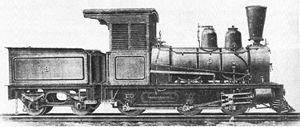BR No. 1 to 3
| BR No. 1 to 3 | |
|---|---|
|
Locomotive No. 3 (company photo)
|
|
| Number: | 3 |
| Manufacturer: | Falcon |
| Year of construction (s): | 1893 |
| Type : | C n2 |
| Gauge : | 610 mm |
| Service mass: | 11.2 t |
| Service mass with tender: | 17.8 t |
| Driving wheel diameter: | 813 mm |
| Cylinder diameter: | 203 mm |
| Piston stroke: | 381 mm |
| Grate area: | 0.44 m² |
| Train brake: | no |
The vehicles with the track numbers 1 to 3 of the Beira Railway (BR) were steam locomotives with a tender with the wheel arrangement C for a track width of 610 mm. Apart from four construction locomotives that had not been given a company number, they were the first locomotives on the railway.
history
The procurement of the rails and all rolling stock for the Beira Railway was carried out by the manufacturer Kerr Stuart . The latter awarded the contract to the Falcon Engine and Car Works to build five locomotives (in addition to the three C couplers, there were two tank locomotives with a B1 'wheel arrangement). The locomotives were delivered with Kerr Stuart nameplates.
Like the 2'B locomotives of classes F2 and F4, locomotives No. 1 to 3 were also parked after the conversion of the Beira Railway to Cape Gauge, which was completed in 1900, and sold as relatively new machines. Little is known about their further fate; two of the locomotives made it to the Selukwe Peak Light Railway in Rhodesia in 1923 together with F2 or F4 locomotives .
technology
The locomotives No. 1 to 3 had an external sheet metal frame. The cylinders, which were also on the outside, were slightly inclined and acted on the central coupling axis. The internal control corresponded to the Stephenson type. The tender had two axles only 1.37 m apart. A spark arrester was built into the conical chimney .
The third coupling axle was located behind the standing boiler and ash box under the driver's cab, so that, at 2.90 m, there was a relatively large fixed axle base for narrow-gauge locomotives of this size. This led to poor running properties, and at least one of the locomotives (No. 1) was converted to the B1 'wheel arrangement by replacing the last coupling axle with a running axle . No information is available on the success of this measure; however, no further locomotives of this type were procured, and all subsequent locomotives on the railway had the 2'B wheel arrangement (classes F2 and F4 ). The only difference between the F2 and the C couplers is that the first coupling axle was replaced by a bogie .
Individual evidence
literature
- Antony Baxter: The Two Foot Gauge Enigma - Beira Railway 1890-1900 . Plateway Press, ISBN 1-871980-34-8
